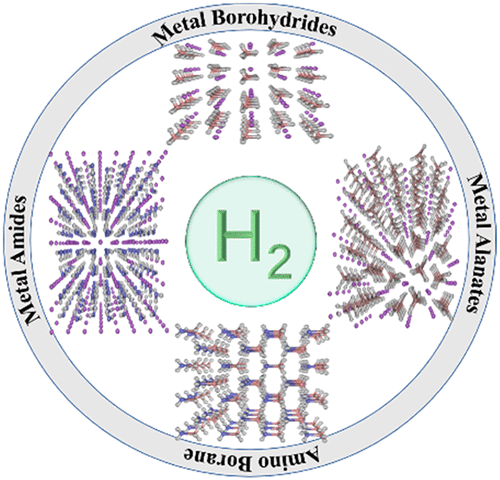当前位置:
X-MOL 学术
›
Ind. Eng. Chem. Res.
›
论文详情
Our official English website, www.x-mol.net, welcomes your
feedback! (Note: you will need to create a separate account there.)
A Review of High Density Solid Hydrogen Storage Materials by Pyrolysis for Promising Mobile Applications
Industrial & Engineering Chemistry Research ( IF 3.8 ) Pub Date : 2021-02-08 , DOI: 10.1021/acs.iecr.0c04387 Yijing Huang 1 , Yonghong Cheng 1 , Jinying Zhang 1
Industrial & Engineering Chemistry Research ( IF 3.8 ) Pub Date : 2021-02-08 , DOI: 10.1021/acs.iecr.0c04387 Yijing Huang 1 , Yonghong Cheng 1 , Jinying Zhang 1
Affiliation

|
Hydrogen is one of the cleanest energies with potential to have zero carbon emission. Hydrogen storage is a challenging phase for the hydrogen energy application. The safety, cost, and transportation of compressed and liquified hydrogen hinder the widespread application of hydrogen energy. Chemical absorption of hydrogen in solid hydrogen storage materials is a promising hydrogen storage method due to its high storage and transportation performance. Hydrogen storage density, dehydrogenation temperature, and dehydrogenation dynamics are the main challenges for the hydrogen storage materials. The ultimate goal of the system gravimetric capacity was set by the Department of Energy to be 6.5 wt % with a working temperature from −40 to 60 °C. The theoretical densities of most present hydrogen storage materials are even lower than 6.5 wt %, which make it impossible to reach the system gravimetric capacity goal. Only hydrogen storage materials with high theoretical density (≥10 wt %) with further modification have the possibility to reach the goal. However, most of the reviews focus on the research progress of general hydrogen storage materials investigated, many of which have low density. Hydrogen storage materials with high theoretical density including metal borohydrides, metal alanates, ammonia borane, metal amides, and amine metal borohydrides have been reviewed in this article. The pyrolysis and hydrogen absorption conditions of the hydrogen storage materials have been summarized, especially the improvements of the hydrogen storage materials. Furthermore, the challenges of the hydrogen storage materials have been pointed out. Potential hydrogen storage materials and possible modification methods have also been presented and discussed.
中文翻译:

高密度固态储氢材料热解技术的应用前景
氢是最清洁的能源之一,具有零碳排放的潜力。氢存储是氢能应用中具有挑战性的阶段。压缩和液化氢的安全性,成本和运输阻碍了氢能的广泛应用。固态储氢材料中氢的化学吸收是一种有前途的储氢方法,因为它具有很高的储运性能。储氢密度,脱氢温度和脱氢动力学是储氢材料的主要挑战。能源部将系统重量分析的最终目标设定为6.5 wt%,工作温度为-40至60°C。目前大多数储氢材料的理论密度甚至低于6.5 wt%,这使得不可能达到系统的重量目标。只有经过进一步改良的理论密度较高(≥10wt%)的储氢材料才有可能达到目标。然而,大多数评论集中于所研究的一般储氢材料的研究进展,其中许多储氢材料密度低。本文综述了理论密度高的储氢材料,包括金属硼氢化物,金属铝酸盐,氨硼烷,金属酰胺和胺金属硼氢化物。总结了储氢材料的热解和氢吸收条件,特别是储氢材料的改进。此外,已经指出了储氢材料的挑战。
更新日期:2021-02-24
中文翻译:

高密度固态储氢材料热解技术的应用前景
氢是最清洁的能源之一,具有零碳排放的潜力。氢存储是氢能应用中具有挑战性的阶段。压缩和液化氢的安全性,成本和运输阻碍了氢能的广泛应用。固态储氢材料中氢的化学吸收是一种有前途的储氢方法,因为它具有很高的储运性能。储氢密度,脱氢温度和脱氢动力学是储氢材料的主要挑战。能源部将系统重量分析的最终目标设定为6.5 wt%,工作温度为-40至60°C。目前大多数储氢材料的理论密度甚至低于6.5 wt%,这使得不可能达到系统的重量目标。只有经过进一步改良的理论密度较高(≥10wt%)的储氢材料才有可能达到目标。然而,大多数评论集中于所研究的一般储氢材料的研究进展,其中许多储氢材料密度低。本文综述了理论密度高的储氢材料,包括金属硼氢化物,金属铝酸盐,氨硼烷,金属酰胺和胺金属硼氢化物。总结了储氢材料的热解和氢吸收条件,特别是储氢材料的改进。此外,已经指出了储氢材料的挑战。





















































 京公网安备 11010802027423号
京公网安备 11010802027423号